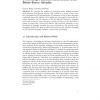Free Online Productivity Tools
i2Speak
i2Symbol
i2OCR
iTex2Img
iWeb2Print
iWeb2Shot
i2Type
iPdf2Split
iPdf2Merge
i2Bopomofo
i2Arabic
i2Style
i2Image
i2PDF
iLatex2Rtf
Sci2ools
SEC
2008
2008
Protecting Financial Institutions from Brute-Force Attacks
We examine the problem of protecting online banking accounts from password brute-forcing attacks. Our method is to create a large number of honeypot userID-password pairs. Presentation of any of these honeypot credentials causes the attacker to be logged into a honeypot account with fictitious attributes. For the attacker to tell the difference between a honeypot and a real account he must attempt to transfer money out. We show that is simple to ensure that a brute-force attacker will encounter hundreds or even thousands of honeypot accounts for every real break-in. His activity in the honeypots provides the data by which the bank learns the attackers attempts to tell real from honeypot accounts, and his cash out strategy.
Honeypot Accounts | Honeypot Credentials | Honeypot UserID-password Pairs | SEC 2008 | Security Privacy |
| Added | 30 Oct 2010 |
| Updated | 30 Oct 2010 |
| Type | Conference |
| Year | 2008 |
| Where | SEC |
| Authors | Cormac Herley, Dinei A. F. Florêncio |
Comments (0)

